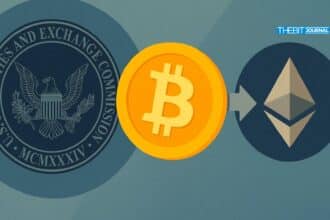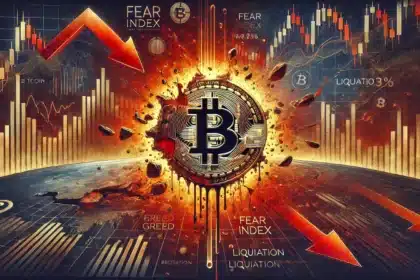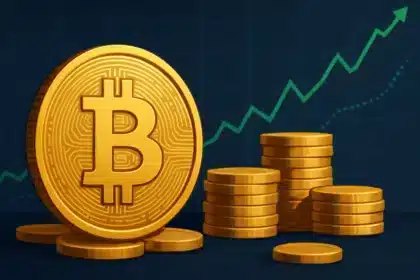Between May 4 and 9, 2025, crypto whales (large holders and institutional players) made a lot of notable moves across blue-chip tokens and meme coins. Bitcoin led the way, as dormant “old whales” woke up and moved thousands of BTC to exchanges.
Meanwhile, Ethereum’s big holders were buying, data shows addresses with 10,000–100,000 ETH added roughly 280,000 ETH ($510 M) in early May and an institutional fund (Abraxas Capital) pulled 41,269 ETH ($75.5 M) from Binance and Kraken on May 8.
Other big-cap coins saw big whale flows: XRP whales moved 370 million XRP ($782 M) in two big transfers, and one trader opened a $16.6 M, 20×-leveraged short position on 100,000 SOL via Hyperliquid.
In the altcoin and meme sector, whales piled into high-volatility tokens. Avalanche’s large-holder netflow surged over 380%, and meme-coins went crazy: one whale bought 500 billion PEPE ($4.36 M) on May 8, and Floki Inu’s large addresses (holding 87% of supply) transacted ~$18.8 M on-chain in the same week.
These big whale moves are getting a lot of attention. Traders and analysts note that big transfers often precede volatility: big inflows to exchanges can put pressure on prices, while big buy orders can spark rallies. In short, this week’s crypto whale activity is a sign of changing sentiment, evidence of both confidence (big buys and withdrawals to cold wallets) and caution (deposits to exchanges and leveraged shorts). As we’ll see below, on-chain data and expert commentary suggest these flows are already impacting market momentum and may set the tone for the next leg of this bull cycle.
Bitcoin Whales: Old Giants Stir
Bitcoin’s early-May rally which crested above $100,000 on May 9 has coincided with historic whale activity. Multiple 10+-year-dormant addresses woke up. One 12-year-old wallet (originating from defunct BTC-e) reportedly moved 3,422 BTC (≈$324 M) to a new address. Around the same time, another 11.8-year-dormant wallet sent 2,343 BTC (≈$222 M) into circulation. Crypto analytics outlet Whale Alert confirmed these on-chain transfers spiked in early May, saying “old investors are starting to liquidate assets or prepare strategic moves”.
At the same time, several whale-size transfers hit exchanges. In early May, 2,402 BTC reportedly moved from the “Ceffu” wallet to Binance, 600 BTC to Bitfinex, and over 4,000 BTC combined from Cumberland and unknown wallets into Coinbase Institutional accounts. These flows, huge deposits to trading venues, often precede selling pressure.
Traders note, for example, that the crypto whale who moved 1,079 BTC (worth ~$109 M) to Gemini on May 9 did so right after Bitcoin broke $100K. “This large-scale movement to an exchange often means selling pressure,” analyst commentary warns, and many market participants are watching for short-term pullbacks.

Despite those deposits, net exchange flows were still negative. According to Coinglass, exchanges saw a net outflow of ~15,700 BTC in the week ending May 9, bringing on-exchange balances to 2.2 million BTC. This means many whales and institutions are actually withdrawing coins to cold storage. CryptoQuant’s “exchange whale ratio” also fell, meaning less selling pressure from big holders.
In practice, analysts say this mixed behavior of whales moving BTC both on and off exchanges is a tug-of-war between profit-taking and long-term accumulation. As one report notes, old whales “actively shift their assets to exchanges” (i.e. sell) even as long-term holders like MicroStrategy keep buying.
Implication: Bitcoin around $100K will be volatile. Whale deposits could trigger short-term drops, but heavy off-exchange withdrawals mean underlying deflationary trend. Traders should watch order books closely; some will short rallies and others will buy dips (especially with broader risk-on from equities).
Ethereum Whales: Big Buys and Withdrawals
Ethereum whales made headlines in early May. On the buy side, on-chain analytics platforms report large ETH holders are aggressively adding to their stacks. Santiment data show wallets with 10,000–100,000 ETH collectively bought ~280,000 ETH (≈$510 M) in the first week of May. This cohort now controls 25.24 million ETH, a one-month high, and if accumulation continues, could mean a bullish breakout.
Another on-chain survey (Binance’s Coinstages) says Ether rose ~3% as “whales continue to accumulate” and warns if buying continues, ETH could surpass $2,000. But Ethereum also saw whale capital flows on exchanges. A notable example: Abraxas Capital (a crypto fund) withdrew 41,269 ETH (≈$75.5 M) from Binance and Kraken on May 8.
Large withdrawals from major exchanges are usually bullish, coins moved off exchanges tend to be held long-term. As one report notes, Abraxas’s move “means substantial institutional accumulation” and will tighten supply. These withdrawals coincided with a ~12% volume surge on Binance as traders rushed to fill the institutional-sized hole.
Implication: Whales accumulating ETH, especially institutions, adds to the upside. Analysts say major inflows into ETFs and futures are reversing (ETH ETFs saw inflows recently) and support the bullish case. But experts warn a sudden flip (e.g. macro shock) could trigger profit-taking, so traders are to prepare for both.
XRP Whales: $782M Shift and Quiet Accumulation
Ripple’s XRP also saw big crypto whale activity this week. On May 8–9, two huge transfers of 370 million XRP (≈$782 million) were recorded. Whale Alert shows a 300 M XRP move ($633.7 M) from a Ripple-controlled address to another wallet and a 70 M XRP transfer ($148.3 M) between unknown wallets. This $782 M shift coincided with a small dip in XRP’s price but it quickly stabilized at $2.10.
Some in the community think it’s treasury rebalancing or an institutional buy, others see it as prelude to supply drops (if moves to exchanges follow). One strategist says Ripple whales are taking a long-term stance rather than reacting to short-term macro signals, so these transfers might not be panic sales. Indeed, on-chain data from Santiment shows holders with 1–10 million XRP increased their share of the supply from 8.24% in January to 9.44% in May. In other words, big players have been accumulating for months.

But market watchers are to remain cautious. Despite the whale activity, XRP is still 35% below 2024 highs and analysts say “accumulation doesn’t always mean instant gains”. With regulatory uncertainty still looming, some think whales are just position-scratching. For now, XRP is trading at $2.30 but if 300+ million XRP moves to exchanges, it could overwhelm liquidity and create volatility.
Implication: The size of these XRP transfers has created noise in the market. If crypto whales sell, XRP could retest lower support; if not, the quiet accumulation (and a possible new Ondo Finance treasury product on XRPL) might set the stage for a later rally. Traders will see if these big moves trigger follow-through or fade as one-off rebalancing.
SOL Whales and Leveraged Positions
Solana itself saw a very different kind of whale activity. Instead of big spot buys, one whale took a massive leveraged short against SOL. According to on-chain analysts, a trader transferred 1.212 million USDC into Hyperliquid and entered a 20× short position on 100,000 SOL (≈$16.6 M notional) on May 9. This is essentially a $16.6 M bet that SOL will drop. The entry was $164.90 per SOL, with a liquidation at $172.60. By the time of reporting, the position was underwater by ~$182,000, so SOL has rallied since the trade.
Such high-leverage moves from a whale can create short-term volatility. The trader presumably expects short-term downward pressure on SOL (perhaps betting on a broader crypto correction). For the market, it means near-term risk: if SOL drops, this whale will profit big time, but if SOL keeps going up, the position will liquidate and add fuel to the rally. Analysts say leveraged whale trades “increase volatility and can influence short-term trading sentiment” in Solana and related derivatives.
Implication: Solana’s price could be choppy. Short term traders should watch this crypto whale’s position. If SOL dips, some may join the short squeeze; if SOL surges (keeps the whale underwater) it could trigger forced sells that briefly spike volatility. In any case, this whale activity is a warning around SOL in the short term.
Altcoin and Meme-Coin Whales
Beyond the majors, whales targeted select altcoins and memes in early May:
- Avalanche (AVAX): Large holders went long on AVAX. IntoTheBlock data shows Avalanche’s 0.1%-supply wallets saw netflows of ~380% over 7 days. If that continues, AVAX could go to $30.
- PEPE (PEPE): The top meme-coin got one of the biggest single buys of the week. On May 8th, a whale bought 500 billion PEPE (~$4.36M) in one go. After the trade, this holder had 2 trillion PEPE ($17.4M total). The buy coincided with a +40% meme-coin rally and 35% 24h volume increase. Analysts say that’s a big accumulation, which could spark short term momentum (though subject to wild swings).
- Floki Inu (FLOKI): Whale interest in Floki also picked up. A Binance research note says 87% of all FLOKI tokens are in large addresses and whales moved ~$18.78M worth of FLOKI on-chain in the past week. Half of current holders are in profit, which means demand is sticky. With a 0.93 correlation to Bitcoin, Floki might ride any BTC rally.
- Other Memes (BONK, TRUMP, etc.): While exact whale metrics are harder to come by, the trend is clear: Solana meme coins like BONK saw big price jumps (BONK is up ~60% in a week on rising open interest) and novelty coins (e.g. “OFFICIAL TRUMP”) got attention. Traders are watching on-chain signs. As one analyst put it, “whale accumulation often precedes big price action” in these tokens.
Implication: Meme coins are back. Large whales buying PEPE and high concentration in Floki means risk appetite is growing. But markets warn that such moves can reverse quickly if sentiment flips. Retail traders will be watching order books and social media hype: a big whale buy can trigger FOMO but also pump-and-dump fears. Overall whale flows into these smaller tokens is a “risk on” signal in crypto right now.

Market Sentiment and Analyst Takeaways
Crypto analysts agree that this concentrated whale activity is influencing market psychology. On one hand, big buy orders and withdrawals to cold wallets mean confidence and bullish momentum.
A senior analyst said that when big holders “ramp up their accumulation,” it means they see current prices as good. For example, Santiment and IntoTheBlock metrics show whales in Bitcoin, Ethereum and Avalanche are accumulating which could mean broader rallies. Institutional flows such as ETF inflows and capital migrations have backed this up and so has Abraxas.
On the other hand, whale activity injects volatility. A whale dumping 1,000+ BTC or opening a $16M short can spook the market. Analysts are warning that accumulation doesn’t always mean instant gains. They point to macro crosswinds. Some strategists advise watching on-chain flows in real time, a deposit to an exchange can be a sell signal, a big off-exchange transfer can be a buy opportunity if prices hold.
In summary, early May’s whale moves have amplified market momentum and uncertainty. Big purchases in ETH, PEPE and AVAX have backed recent rallies; big transfers to exchanges and a mega SOL short add cautionary risk. With Bitcoin and other cryptos at critical levels, those whales have a lot of power: their next move will decide if the current upswing continues or takes a breather.
FAQs
What are crypto whales and why do they matter?
Crypto whales are individuals or entities holding large amounts of a specific ‘cryptocurrency. Their transactions can move the market because of the size they control, ‘often causing sharp market moves or shifts in investor sentiment.
How can whale activity impact short term market trends?
Whale activity, such as big inflows to exchanges or dormant wallets activating, can mean upcoming volatility. These actions can cause sudden price swings or liquidity shifts, which can impact retail investor decisions and algorithmic trading.
Which tools track crypto whale movements?
Whale Alert, Lookonchain, Arkham Intelligence, Nansen, and Spot On Chain are popular tools. They track large on-chain transactions and provide real-time notifications on big crypto wallet activity.
Are whales manipulating the 2025 crypto rally?
There is no direct evidence of manipulation but coordinated whale activity has matched market trends in May 2025. Their actions , buying the dips or selling the rallies, can amplify or stall the bullish momentum.
What to watch when analyzing whale activity?
Wallet inflows/outflows, sudden activation of dormant addresses, exchange deposits and multi-token accumulation trends. Combine these with market sentiment and technicals for deeper trading insights.
Glossary
Crypto Whale: A crypto investor or institution ‘that holds a large amount of a specific digital asset. Whales can move markets because of the size of their trades.
Dormant Wallet: A cryptocurrency wallet that hasn’t had any activity (deposits or withdrawals) for a long time. Activation of dormant wallets can sometimes signal big moves or market ‘shifts.
Exchange Inflow: Transferring crypto from a private wallet to an exchange. Often seen as a sell signal.
Exchange Outflow: Transferring from an exchange wallet to a private wallet or cold storage. Usually a bullish sign meaning long term holding.
On-Chain Data: Blockchain transaction data that can be analyzed for wallet movements, gas fees, token transfers and contract interactions. Crucial for tracking whale behavior.




























